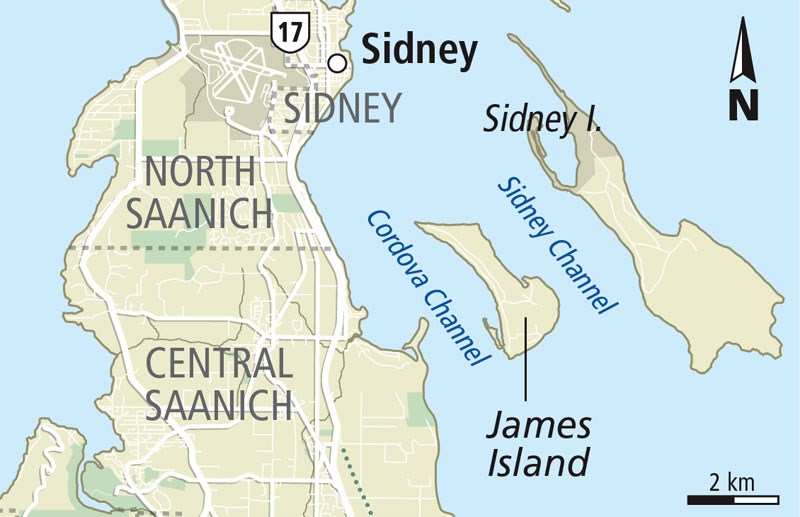James Island is a wild place, a rich man’s private retreat floating a couple of kilometres southeast of Sidney.
The size of downtown Victoria, the island crawls with fallow deer descended from the game animals imported more than a century ago when B.C.’s premier, Sir Richard McBride, was among those who used it as a private hunting reserve.
An old powder-shipping wharf is a reminder of the dynamite plant that churned out explosives for two world wars. The TNT that all but destroyed Halifax in 1917 was manufactured there.
In 1994, the island was bought by Seattle telecommunications billionaire Craig McCaw who, although not a golfer, completed the 18-hole Jack Nicklaus-designed golf course begun by the previous owners. There’s also a 5,000-square-foot main house, a half-dozen guest cottages, a manager’s residence, a pool house, a private air strip and a western-themed “village” housing a library, a full gym and kitchens. McCaw put it all on the market for $75 million two years ago, around the same time he paid a world record $35 million for a car, a 1962 Ferrari 250 GTO built for Sir Stirling Moss.
Not that Tim Ennis cares about any of that.
The West Coast program manager for the Nature Conservancy of Canada, Ennis is more interested in the sand verbena moths. They’re way rarer than a Jack Nicklaus golf course. One of the handful of places the moths can still be found is James Island.
“They’re as endangered as you can get without going extinct,” Ennis says, standing on a sandspit at the north end of the island.
In fact, a bunch of endangered species, from the Edward’s beach moth to a scraggly, wiry plant called the contorted pod evening primrose, can be found on this sandspit. That’s why it’s strictly off-limits, even to McCaw, a committed environmentalist who has voluntarily turned one-fifth of his island into a permanently protected conservation area.
Only the nature conservancy may let people enter the areas — largely the sandspit and the salt marshes by the powder wharf — covered by the conservation covenant, which will remain in effect even after the island is sold. For the past few years, the only feet meant to be treading the soil have belonged to those waging war on the gorse and Scotch broom.
That includes a group of a dozen volunteers led up the spit by Ennis and colleague Katy Fulton this week. They spent the day digging up European beach grass, laying fabric to choke out gorse that was trying to make a comeback, uprooting the crow garlic descended from the backyard gardens of old.
Their efforts have paid off. The endangered bits are rebounding. With the invasive plants gone, species like yellow sand verbena (on which the moth depends) have thrived. The number of evening primrose has jumped from 400 to 10,000. Breeding pairs of kildeer have moved in, laying their eggs in the sand.
This isn’t just conservation for conservation’s sake. There’s an interconnectivity to it all. Where the rest of us just see a lovely stretch of beach, Ennis sees a spawning ground for the smelt, sand lances and other little fish so critical to the diet of chinook salmon, which themselves are critical to orcas. Across the water, such spawning grounds have been destroyed by rip-rapped shoreline.
“We’re trying to keep Canada’s native biodiversity from going extinct,” says Ennis, a hip and healthy-looking (everyone in the NCC looks hip and healthy) outdoor enthusiast.
The Nature Conservancy of Canada is well-established, but flies a little under the radar because so much of what it does is in the nation’s wilderness. It also works closer to built-up areas, though. Vancouver Island projects have included cleaning the industrial mud pit that was the Campbell River estuary and protecting Garry oak habitat near Duncan. A plan to restore the Central Saanich wetland known as Maber Flats, easing flood problems, is in its larval stage.
Some work is done with money from the federal Habitat Stewardship Program. On James Island, the McCaws not only agreed to a conservation covenant, but provided an endowment fund to cover the restoration. That is augmented with volunteer labour like that seen this week; the volunteers ranged from NCC staff to young nature lovers responding to a public appeal. Dr. Blair Fulton, an Oak Bay High grad and Katy’s brother, was on vacation from Vancouver, where he’s doing a hospital residency.
Ennis is grateful for them all, and for the McCaws, who had nothing personal to gain by ceding control over their own property. Some people just like saving the planet.



